Pascale Hémery
"I always experience a strong emotion when the image appears. This experience is the moment of truth, the real test of my drawing. And in this way, whilst the woodblock disintegrates, I see my image gradually come to life."
Interview with artist Pascale Hémery (PH), prepared by Svetlana Sapozhnikova (Emanuel von Baeyer London).
(French translation by Dr. Alexander and Evelyne von Baeyer)
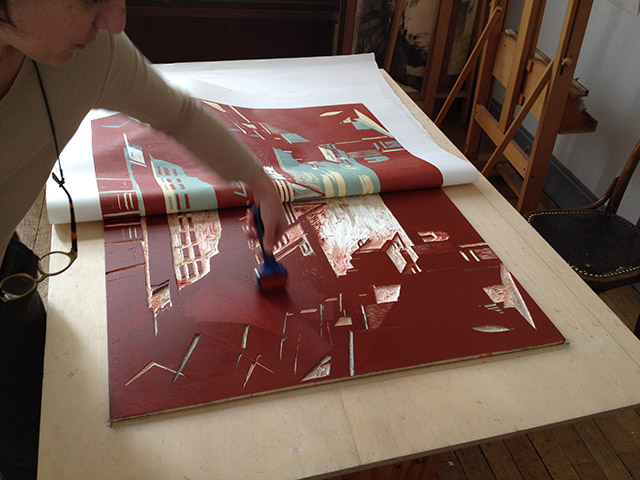
What is your background in the arts, and how did you end up choosing printmaking?
(PH) I first became acquainted with the linocut technique at the Académie Julian in Paris. It conquered me immediately by its expressive power and its graphic efficiency. In order to earn my living, I started to produce illustrations for newspapers and publishing companies using the technique of lino printing. I created these linocuts simply through using a spoon. Later, I enrolled at the School of Fine Arts (Ecole des Beaux-Arts) in Paris. The art of engraving was considered to be obsolete here, but for me it was the opposite! I considered engraving techniques to be an artistic means of expression, perfectly in line with our age of reproduction and meaningful for anyone. The School of Fine Arts gave me an opportunity to familiarize myself and experiment with other techniques, like painting and drawing. I then continued my practical training, attending workshops on lithography and intaglio engravings both in Paris and abroad. Alongside this, I developed my personal artistic style, which I displayed regularly at commercial galleries and museum exhibitions.
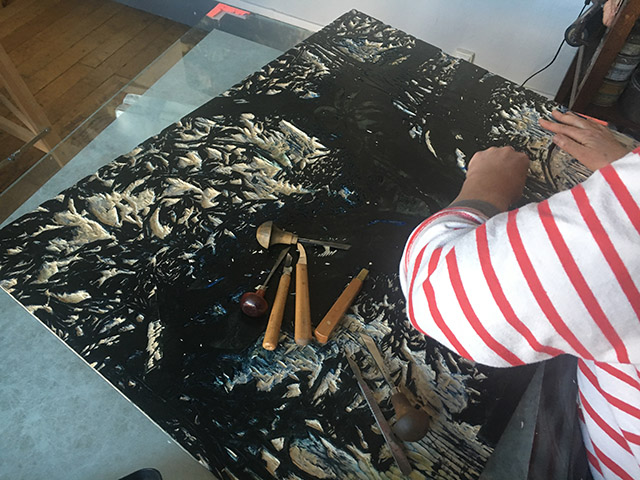
Can you tell us how you took up the medium of colour woodcut?
(PH) I work on the city, or rather the city works in me. The city provokes a real creative excitement for me. What I am looking for is to capture the particular light of the place. Colour allows me to express my emotions.
Departing from the ancient technique of chiaroscuro, I developed my own technique of reduction woodcut (à bois perdu). Using one single block, I make prints in large format and with many colours. I engrave the block stepwise, which I then print gradually in accordance with a variation on the four primary colours. Superimposed on each other, the colours start to interact. In this way I create the light, space and matter simultaneously, by the economy of means. Sometimes, the wood or the linoleum resist my efforts, the gouge slips away. In these moments when I have to cope with the surprises of the material, I discover new ideas.
However, it is the risks my technique forces on me which are the source of my stimulation. I feel like a funambulist on the rope with the void below me – the slightest error and my drawing risks losing all its meaning.
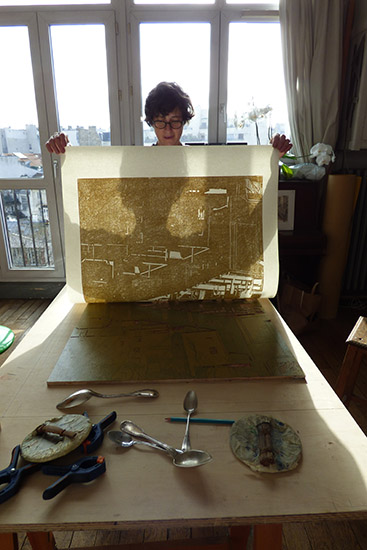
Can you take us through the steps of creating a piece using the medium of woodcutting? How labour intensive is the process? How do you work?
(PH) Before starting the engraving process, I undertake some extensive research work in painting and drawing. Once I have fully understood my drawing, I transfer it onto the block of wood.
Let us take as an example “View from the Flatiron building – New York”, a woodcut in four colours and in 120 x 80 cm format, printed using a spoon on Japanese paper. All this is done in the studio. I use the gouges to guide the light directly onto the woodblock. Each step consists of hollowing out the parts that will not be printed. I use my experience to help me balance the colours.
The printing requires very rigorous preparation to deal with any potential problems I might encounter. Each step demands high concentration. The inking is done with the roller; sometimes I need two people to position the sheet over the entire surface of the woodblock. The printing is done with a spoon, by rubbing. As drawn out as this technique may seem, it is not mechanical. I can adapt the intensity of the colour by varying the pressure and giving a very personal touch to every copy.
I always experience a strong emotion when the image appears. This experience is the moment of truth, the real test of my drawing. And in this way, whilst the woodblock disintegrates, I see my image gradually come to life.

What is your daily routine?
(PH) I am in my studio every day; I depend entirely on the specific time required for engraving and painting. I need to devote the entire day to a work session; then I have to leave my work ‘to rest’, in order to take it up again with a fresh eye.
Towards the evening the natural light changes too much; I take a break, I go out for a walk. Later in the evening I might continue working on a drawing. I don’t do anything on a whim.
Who are your biggest influences in this technique, if any?
(PH) I am fascinated by the colour woodcuts of John Baptist Jackson, an English artist of the 18th century who invented a special technique to reproduce old master paintings, like those of Titian, in order to promulgate them. Nowadays, these woodcuts are far more than reproductions; they make us see classical artworks differently.
For me, everything related to colour engraving is teaching material. I have a predilection for the engravings of the Vienna Secession around 1900; and I am stimulated by the inventiveness of the English Vorticist movement. Picasso’s linocuts were also highly important in my artistic training.
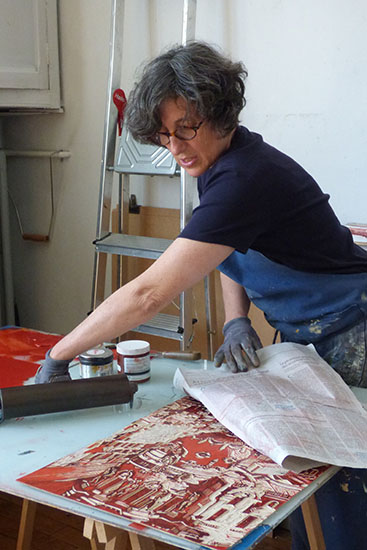
Where does your inspiration come from?
(PH) I draw inspiration from all kinds of arts: painting, cinema and photography. However, any representation of the city today is an object of curiosity for me. Without denying that my first influences came from Expressionism and Franz Masereel, my artistic taste has evolved considerably towards more contemporary painters like Richard Diebenkorn and Alice Neel.
The main subject matter of your work is cities and urban landscapes. Have the recent events of lockdowns and curfews affected how you see cities and urban life?
(PH) The city in lockdown, with nobody in the streets, gives me the impression of being inside my own woodcuts. Fortunately, the suspended time of art is not the arrested time of the lockdown.
In this current period, our constricted world lacks life. The human element that I try to represent is absent; the immense body in motion that is the city freezes, as if the construction site of God’s creation had been put on hold. It is difficult to be creative without this vital energy. It is my artistic destiny to be locked down in my studio. I face this situation and I delve into my own artistic resources to imagine a different world. Having recourse to works of art is a delightful source of consolation for me.
I take the example of Matisse, who knew how to create in much worse circumstances. This continuously astonishes me, and for me it is the only possible dignified way out of this situation.
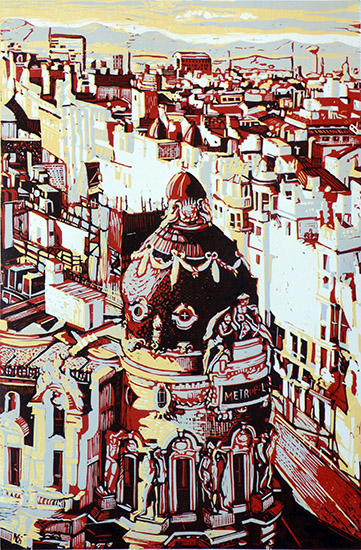
What are you working on currently?
(PH) I have various ongoing projects at the moment. I am making a colour woodcut on Madrid. I am preparing a bibliophile book on Paris and I continue to work on a series of paintings on canvas whose subject matter is southern cities. I don’t have enough time for everything I want to do.